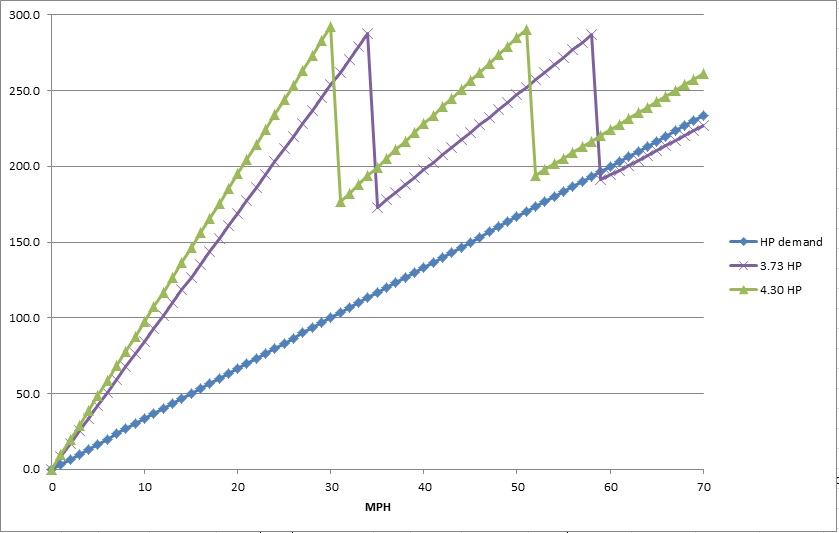Jettix2
Sep 30, 2013Explorer
Towing with a 3.73 F250 6.2L, will a 4.30 axle help ??
Hey guys.......
I have a 2011 F250 Crew Cab SB, 4WD Lariat with 6.2L and 3.73 E-locker. Running 5-Star tuner on it, helps with the throttle-lag and gets true WOT when you put the pedal down. Also has Add-A-Leaf in the rear to help reduce Sag (thanks Ford for softening up the rear suspension on the new SD's so much, ha ha).
Stock 275/65-20 tires.
When I traded in my last truck (08 6.4 Diesel, tired of the headaches) it was the only gasser I could find, the 4.30 axle is elusive unless you special order.
I LOVE the truck. It is my DD to and from work maybe 8k miles a year, towing a light utility trailer (2000-3000#) around from time to time, but only towing our Camper 2-3 times a year (1000 miles per trip).
It pulled our old trailer (298BHS Starcraft Aruba, 6830# dry) pretty well. Has to wind out a lot (5000+ RPMs) on long uphill stretches to hold 60-65mph and fuel mileage sucks, but it was otherwise A-OK getting up to speed safely, etc. I wished for the 4.30 but it was never a necessity, until NOW....
We outgrew the old trailer and now have a 321 BHT Sierra which is 6.5 ft longer and weighs 9400# dry. It's like pulling a house compared to the old trailer.
ProPride 3P on the way to address sway issues with the trailer, but I am stumped on the power. Once I have the trailer up to speed, the truck pulls it OK, but getting up to speed it really struggles.
I can A) pay ~~$2500 and have the truck re-geared with a 4.30 gear set, which will undoubtably HELP the acceleration and hill-holding when loaded.......the question is, how MUCH will it help? I've searched dealers around to see if I can find a 4.30 equipped truck to tow this trailer with, and I can't find one....
Option B) is either trade the truck in and buy a used diesel (and really risk getting someone else's problem again), or C) pony up another $15k to get into a new diesel, which I really don't WANT the maintenance, headaches, and don't want to pay for either;)
Any thoughts on how much difference I'll see swapping these gears?
FWIW I have watched the video on 5-Star tuning's website, which shows Mike towing a 10k trailer with his 6.2L, tuned, 4.30 truck, and it definitely pulls better than mine.........of course, real-world, seat-of-the pants, it's hard to put that into perspective.
I realize, this isn't a race. I don't expect to pull 11k loaded 0-60 in 5 seconds. But, I want to be able to safely pull out, tow, and manage hills in the truck with my family without having to sweat it.
Any thoughts appreciated.
Thanks, Ben
I have a 2011 F250 Crew Cab SB, 4WD Lariat with 6.2L and 3.73 E-locker. Running 5-Star tuner on it, helps with the throttle-lag and gets true WOT when you put the pedal down. Also has Add-A-Leaf in the rear to help reduce Sag (thanks Ford for softening up the rear suspension on the new SD's so much, ha ha).
Stock 275/65-20 tires.
When I traded in my last truck (08 6.4 Diesel, tired of the headaches) it was the only gasser I could find, the 4.30 axle is elusive unless you special order.
I LOVE the truck. It is my DD to and from work maybe 8k miles a year, towing a light utility trailer (2000-3000#) around from time to time, but only towing our Camper 2-3 times a year (1000 miles per trip).
It pulled our old trailer (298BHS Starcraft Aruba, 6830# dry) pretty well. Has to wind out a lot (5000+ RPMs) on long uphill stretches to hold 60-65mph and fuel mileage sucks, but it was otherwise A-OK getting up to speed safely, etc. I wished for the 4.30 but it was never a necessity, until NOW....
We outgrew the old trailer and now have a 321 BHT Sierra which is 6.5 ft longer and weighs 9400# dry. It's like pulling a house compared to the old trailer.
ProPride 3P on the way to address sway issues with the trailer, but I am stumped on the power. Once I have the trailer up to speed, the truck pulls it OK, but getting up to speed it really struggles.
I can A) pay ~~$2500 and have the truck re-geared with a 4.30 gear set, which will undoubtably HELP the acceleration and hill-holding when loaded.......the question is, how MUCH will it help? I've searched dealers around to see if I can find a 4.30 equipped truck to tow this trailer with, and I can't find one....
Option B) is either trade the truck in and buy a used diesel (and really risk getting someone else's problem again), or C) pony up another $15k to get into a new diesel, which I really don't WANT the maintenance, headaches, and don't want to pay for either;)
Any thoughts on how much difference I'll see swapping these gears?
FWIW I have watched the video on 5-Star tuning's website, which shows Mike towing a 10k trailer with his 6.2L, tuned, 4.30 truck, and it definitely pulls better than mine.........of course, real-world, seat-of-the pants, it's hard to put that into perspective.
I realize, this isn't a race. I don't expect to pull 11k loaded 0-60 in 5 seconds. But, I want to be able to safely pull out, tow, and manage hills in the truck with my family without having to sweat it.
Any thoughts appreciated.
Thanks, Ben

